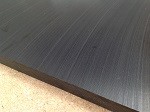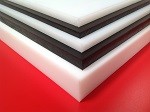In this week’s tech chat we wanted to de-mystify the whole High density Polyethylene HDPE grade chaos and try and simplify the whole subject. We decided to cut to right to the chase and get to the bottom of only what we need to know and also what we don’t.
The crux of the matter
Although you happily order your HDPE sheet, guess what, like most things in life its not quite as simple as that, because someone in their infinite wisdom decided that there should be two grades. So in the sheet grades we have the 300grade and 500grade. The question is, did that “someone” do this for a good reason or have they got a lot of shares in Paracetamol?
What are these numbers anyway?
The 300 and the 500 stand for the density of the plastic molecules, it stands to reason that the 500 grade is denser but are there any major advantages?
That old chestnut
The obvious other difference is the price, we’re not getting our extra density for free and on average the 300 grade is approx 15% cheaper, on a small project its not going to have an effect but on a big project that 15% is going to show.
Bang for buck
We thought we’d get the data sheets out and compare them both in a like for like basis and we’ve tried to list the main ones, and 500 grade is:
- Tensile strength +25% better
- Friction numbers looks to be exactly the same
- Hardness +12% harder
We’d like to have told you that the wear resistance was much better for 500 grade and the general consensus is that it is, but the manufacturers haven’t gotten round to doing any lab data comparison to support this
What else do we need to know?
Well 500 grade is “pressed and planed” when its manufactured, which definitely has its advantages when it comes to stability particularly during and after machining, we’ll be covering this pressed and planed process in a future tech chat. But suffice to say that the whole surface of the sheet will have circular planning marks across it.

The other advantage of 500grade is the range in terms of thickness and colour options. Thickness in 500 will range from 5mm right up to 100mm where as 300grade will generally start at 1mm and stop at 50mm
And as we also mentioned, 500grade is available in a range of colours and is often used as a colour coding system for chopping boards in the food industry.
Rod keeps it simple
Yes, HDPE rod is going to be the “one size fits all” category and they’ve chosen to stick with one grade which is 300 grade so at least the confusion is limited to sheet only.
The Key parts then are:
- 300 grade is approx 15% cheaper
- 500 grade is 25% stronger & 12% harder
- 500 grade probably has a better wear resistance
- 500 grade is more stable once machined
- 500 grade is available in a greater thickness range
- 500 grade is available in a range of colours
- 500 grade surface is going to have circular planning marks










